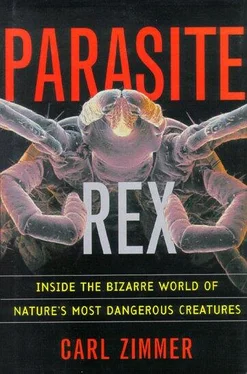Parasite Rex
Inside the Bizarre World of Nature’s Most Dangerous Creatures
by Carl Zimmer
Prologue:
A Vein Is a River
The boy in the bed in front of me was named Justin, and he didn’t want to wake up. His bed, a spongy mat on a metal frame, sat in a hospital ward, a small concrete building with empty window frames. The hospital was made up of a few of these buildings, some with thatched roofs, in a wide dusty courtyard. It felt more like a village than a hospital to me. I associate hospitals with cold linoleum, not with goat kids in the courtyard, punching udders and whisking their tails, not with mothers and sisters of patients tending iron pots propped up on little fires under mango trees. The hospital was on the edge of a desolate town called Tambura, and the town was in southern Sudan, near the border with the Central African Republic. If you were to travel out in any direction from the hospital, you would head through little farms of millet and cassava, along winding paths through broken forests and swamps, past concrete-and-brick funeral domes topped with crosses, past termite mounds shaped like giant mushrooms, past mountains covered in venomous snakes, elephants, and leopards. But since you’re not from southern Sudan, you probably wouldn’t have traveled out in any direction, at least not when I was there. For twenty years a civil war had been lingering in Sudan between the southern tribes and the northerners. When I visited, the rebels had been in control of Tambura for four years, and they decreed that any outsiders who arrived on the weekly prop plane that landed on its muddy airstrip could travel only with rebel minders, and only in the daytime.
Justin, the boy in the bed, was twelve years old, with thin shoulders and a belly that curved inward like a bowl. He wore khaki shorts and a blue-beaded necklace; on the window ledge above him was a sack woven from reeds and a pair of sandals, each with a metal flower on its thong. His neck was so swollen that it was hard to tell where the back of his head began. His eyes bulged in a froglike way, and his nostrils were clogged shut.
“Hello, Justin! Justin, hello?” a woman said to him. There were seven of us there at the boy’s bedside. There was the woman, an American doctor named Mickey Richer. There was an American nurse named John Carcello, a tall middle-aged man. And there were four Sudanese health workers. Justin tried to ignore all of us, as if we’d all just go away and he could go back to sleep. “Do you know where you are?” Richer asked him. One of the Sudanese nurses translated into Zande. He nodded and said, “Tambura.”
Richer gently propped him up against her side. His neck and back were so stiff that when she lifted him he rose like a plank. She couldn’t bend his neck, and as she tried, Justin, his eyes barely open, whimpered for her to stop. “If this happens,” she said emphatically to the Sudanese, “call a doctor.” She was trying to hide her irritation that they hadn’t called her already. The boy’s stiff neck meant that he was at the edge of death. For weeks his body had been overrun with a single-celled parasite, and the medicine Richer was giving him wasn’t working. And there were a hundred other patients in Richer’s hospital, all of whom had the same fatal disease, called sleeping sickness.
I had come here to Tambura for its parasites, the way some people go to Tanzania for its lions or Komodo for its dragons. In New York, where I live, the word parasite doesn’t mean much, or at least not much in particular. When I’d tell people there I was studying parasites, some would say, “You mean tapeworms?” and some would say, “You mean ex-wives?” The word is slippery. Even in scientific circles, its definition can slide around. It can mean anything that lives on or in another organism at the expense of that organism. That definition can include a cold virus or the bacteria that cause meningitis. But if you tell a friend with a cough that he’s harboring parasites, he may think you mean that there’s an alien sitting in his chest, waiting to burst out and devour everything in sight. Parasites belong in nightmares, not in doctors’ offices. And scientists themselves, for peculiar reasons of history, tend to use the word for everything that lives parasitically except bacteria and viruses.
Even in that constrained definition, parasites are a vast menagerie. Justin, for example, was lying in his hospital bed on the verge of death because his body had become home to a parasite called a trypanosome. Trypanosomes are single-celled creatures, but they are far more closely related to us humans than to bacteria. They got into Justin’s body when he was bitten by a tsetse fly. As the tsetse fly drank his blood the trypansomes poured in. They began to steal oxygen and glucose from Justin’s blood, multiplied and eluded his immune system, invaded his organs, and even slipped into his brain. Sleeping sickness gets its name from the way trypansomes disrupt people’s brains, wrecking their biological clock and turning day to night. If Justin’s mother hadn’t brought him to the Tambura hospital, he would certainly have died in a matter of months. Sleeping sickness is a disease without pardon.
When Mickey Richer had come to Tambura four years earlier, there were hardly any cases of sleeping sickness, and people generally thought of it as a disease that was fading into history. That wasn’t always the case. For thousands of years, sleeping sickness has threatened people in the range of the tsetse fly: a wide swath of Africa south of the Sahara. A version of the disease also attacked cattle and kept vast regions of the continent free of domesticated animals. Even now, over 4.5 million square miles are off limits to cattle in Africa because of sleeping sickness, and even where people do raise cattle, 3 million die of sleeping sickness each year. When Europeans colonized Africa, they helped trigger giant epidemics by forcing people to stay and work in tsetse-infested places. In 1906, Winston Churchill, who was the colonial undersecretary at the time, told the House of Commons that one sleeping sickness epidemic had reduced the population of Uganda from 6.5 million to 2.5 million.
By World War II, scientists had discovered that drugs effective against syphilis could also eradicate trypanosomes from the body. They were crude poisons, but they worked well enough to make the parasites sink back down to low levels if doctors carefully screened places thick with tsetse flies and treated the sick. There would always be sleeping sickness, but it would be an exception, not the rule. Campaigns against sleeping sickness during the 1950s and 1960s were so effective that scientists talked of eliminating the disease in a matter of years.
But war, crumbling economies, and corrupt governments let sleeping sickness come back. In Sudan the civil war drove away Belgian and British doctors from Tambura County; they had been keeping a careful watch for outbreaks. Not far from Tambura, I visited an abandoned hospital that had had its own sleeping sickness ward; now it is filled with wasps and lizards. As the years passed, Richer watched her load of sleeping sickness cases rise, first to 19, then to 87, then to hundreds. She ran a survey in 1997 and estimated from it that 20 percent of the people in Tambura County—12,000 Sudanese—carried sleeping sickness.
That year Richer launched a counteroffensive, hoping to fight back the parasite at least in Tambura county. For people who were still in the early stages of the disease, ten days of injections in the buttocks with the drug pentamidine was enough. For those like Justin who had the parasites in their brains, a harsher course was necessary. They needed stronger stuff that could kill the parasite outright in their brain—a brutal potion known as melarsoprol. Melarsoprol is made of 20 percent arsenic. It can melt ordinary plastic IV tubes, so Richer had to have tubes flown in that were as tough as Teflon. If melarsoprol seeps out of a vein, it can turn the surrounding flesh into a swollen, painful mass; then, at the very least the drugs have to be stopped for a few days, and at worst the arm may have to be amputated.
Читать дальше











